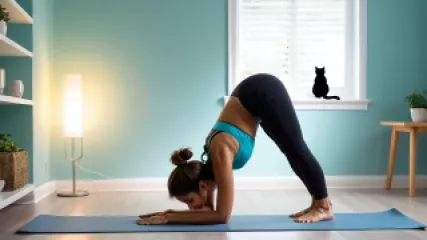Yoga Poses for Mental Health: A Step-by-Step Guide
Introduction
In today's fast-paced and stressful world, taking care of our mental health is more important than ever. One powerful tool that has gained popularity in recent years is yoga. Yoga not only helps in improving physical fitness but also has numerous mental health benefits. It combines mindful movement with breathwork, creating a holistic practice that can reduce stress, promote relaxation, and enhance overall well-being.
In this step-by-step guide, we will explore various yoga poses specifically tailored to support mental health. Whether you are a beginner or have some experience with yoga, these poses can be incorporated into your daily routine to cultivate a greater sense of calm, balance, and clarity.
1. Child's Pose (Balasana)
Begin by kneeling on the floor with your knees hip-width apart and your big toes touching. Sit back on your heels and gently fold forward, extending your arms in front of you. Rest your forehead on the mat or a block if it reaches comfortably. Take slow, deep breaths, allowing your body to relax and release tension.
This pose helps to calm the mind, relieve anxiety, and gently stretch the lower back and hips.
2. Legs-Up-The-Wall Pose (Viparita Karani)
Lie on your back and bring your legs up against a wall, forming an L shape with your body. Keep your arms relaxed by your sides, palms facing up. Close your eyes and focus on your breath as you let go of any stress or tension. Stay in this pose for several minutes, allowing the benefits to sink in.
Legs-Up-The-Wall pose promotes relaxation, improves circulation, and soothes the nervous system. It can be particularly helpful for relieving insomnia and calming a busy mind.
3. Cat-Cow Pose (Marjaryasana-Bitilasana)
Start on your hands and knees, aligning your wrists under your shoulders and your knees under your hips. Inhale as you drop your belly towards the mat, lifting your head and tailbone up—creating an arched back (Cow Pose). As you exhale, round your spine towards the ceiling, tucking your chin and tailbone in (Cat Pose). Move through these two poses with the rhythm of your breath.
Cat-Cow pose helps to release tension in the spine, increase flexibility, and bring awareness to the breath, promoting a sense of grounding and stability.
4. Standing Forward Fold (Uttanasana)
Stand tall with your feet hip-width apart. On an exhale, hinge forward from the hips, allowing your upper body to drape over your legs. Bend your knees if needed and let your head hang heavy. You can hold onto opposite elbows or simply let your arms dangle towards the ground. Take slow breaths as you surrender into the pose.
Standing Forward Fold calms the mind, relieves stress, and stretches the hamstrings and lower back. It also encourages blood flow to the brain, promoting mental clarity and focus.
5. Bridge Pose (Setu Bandha Sarvangasana)
Lie on your back with your knees bent and feet flat on the mat. Place your arms alongside your body, palms facing down. On an inhale, press your feet into the ground and lift your hips off the mat, coming into a bridge position. Engage your glutes and inner thighs as you lengthen through the chest. Hold the pose for a few breaths before gently lowering your spine back down.
Bridge pose helps to alleviate stress, calm the mind, and energize the body. It also strengthens the legs, glutes, and core muscles.
6. Corpse Pose (Savasana)
Lie flat on your back with your legs extended and arms relaxed by your sides, palms facing up. Close your eyes and allow your body to completely relax into the mat. Bring your awareness to your breath, letting go of any thoughts or distractions. Stay in this pose for at least 5-10 minutes, absorbing the benefits of deep relaxation.
Corpse pose is a deeply restorative pose that promotes relaxation, reduces anxiety, and cultivates a sense of inner peace. It is often practiced at the end of a yoga session to integrate the benefits of the practice.
Conclusion
Yoga poses can be powerful tools for improving mental health and well-being. By incorporating these poses into your daily routine, you can cultivate a greater sense of calm, reduce stress, and enhance overall mental clarity. Remember to listen to your body and modify the poses as needed. Consistency is key, so try to make yoga a regular part of your self-care routine. As you embark on this journey of yoga for mental health, may you find balance, peace, and a deeper connection with yourself.






